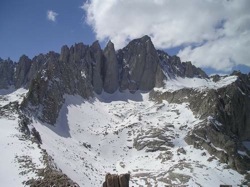Loot from the recent invasion of email servers at the Climatic Research Unit (CRU) in Britain has raised questions about whether scientists who dissent from the prevailing views of climate research are being muzzled by their colleagues.

An interesting example of this arose this week in a report by Richard Harris for NPR’s All Things Considered. It’s worth a listen, if only for the back-and-forth between two climate scientists over snowfall in the southern Sierra Nevada mountains. John Christy of the University of Alabama, Huntsville, tells Harris about trouble he’s had publishing research that appears to counter the mainstream view that the Sierra snowpack is endangered. For a response, Harris goes to Philip Mote at Oregon State University, one of the scientists who reviewed Christy’s research.
Also interviewed are Gavin Schmidt of NASA and Judy Curry from Georgia Tech.
The head of the UN’s climate panel finally issued his own statement on the email flap, which was part condemnation of the hackers, part defense of the science and peer review process.
2 thoughts on “Sierra Snow: Scientists in Heated Agreement”
Comments are closed.

Here is a link to the Who’s Who in the Climategate email flap:
http://ncwatch.typepad.com/media/2009/11/whos-who-in-climategate-the-video.html
The discussions on Sierra Nevada snow fall are not addresssing the snow parameters that the prevaling models have predicted are being most affected by climate change. It is the spring snow pack that is disappearing. During my lifetime (currently 63) the Sierra spring snowpack has declined significantly. The models that I have read about predict that this decline will accelerate such that the snow pack on April 1st will be less than 20% of current April 1st snowpack by 2030. Most models have actually predicted that precipitation may increase resulting in higher snow fall above the winter freezing level, but warmer spring temperatures will accelerate decline of the snow pack.
As anecdotal evidence, a local Sierra Nevada ski resort in the 70’s held a community slalom race on a local snow field on July 4th. This race was discontinued in the late 70’s because the snow pack did not persist long enough to allow it. Loss of a number of glaciers in the North Cascades has occurred since 1973 because the spring snow pack has not persisted to offset summer melting. The summer ski camp at the Whistler Ski Area in British Columbia that was held on Whistler Peak was discontined a decade or more ago and the summer snowfield has disappeared. The two T-bar lifts that were used for the ski camp are now stranded high and dry in the summer. The summer ski camp was moved higher to Blackcomb Glacier, which will serve it for a while. Blackcomb Glacier is also receding quite rapidly. British Columbia government scientists have predicted that the province’s alpine glaciers may disappear by the turn of the next century.
If precipitation does increase resulting in higher (or the same) snow fall at higher elevations with warming of the adjacent Pacific Ocean waters, snow fall could increase even though the overall spring snow pack may continue its current decline.